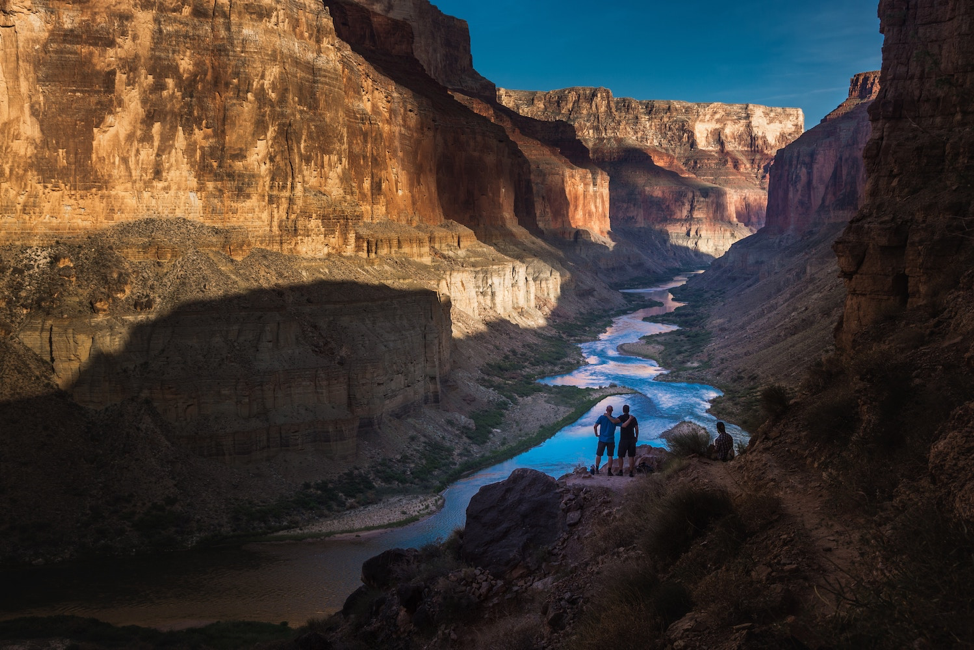Earth Law Communication Tips
Figure 1 Photo by Martin Permantier on Unsplash
By Helen George
INTRODUCTION
This blog is about how to make readers feel welcome. It outlines how to shape content to meet readers “where they are at.” Empathy for the reader is crucial for effective communication.
Communicators take the message to the reader
Communicators understand the reader’s struggles
Communicators work to actively engage the reader
The first section explains how to tailor content to make it suitable for particular readership groups. The second looks at how word choices exclude readers. The final section introduces storytelling as a way to appeal to everyone.
SECTION 1 — KNOW YOUR AUDIENCE
When everything we write supports the message we want to communicate, we have the chance to produce well structured writing. Content that serves no purpose is difficult to place into a logical outline.
To know whether content serves a purpose we have to understand why we are communicating, who we are communicating to and how we want them to respond.
Defining our purpose
What’s the message?
Who’s it for?
What response do we want?
Earth law writing is designed to be read by a diverse readership: environmental and legal specialists, the general public, and community leaders. We write to tell readers what Earth law is. We ask readers to support specific causes such as individual rivers and mountains.
Figure 2 Photo by Nicole Honeywill on Unsplash
Who are our readers?
Each readership group is a niche. The needs of one niche can be very different to the needs of another.
Writing for lawyers about the rights of rivers is not like writing for non-specialists. The second group need to know how the law works. Lawyers know the law and want further legal detail.
Having a clear idea about the needs of a readership helps us to produce well structured writing that communicates a message.
Taking inspiration from magazine journalism
Magazines cater for specific readerships. Watching magazine journalists at work is a lesson in how to structure content towards unique audiences. These writers think logically about how to shape stories that are most likely to interest their intended readers.
Case study – Red Fen wetland
Jenny goes eco-camping in Red Fen wetland. Afterwards she submits articles to nature and ecology magazines.
“10 rare birds in Red Fen wetland” goes to Birdwatching weekly. She focuses on birds because birds are a priority interest for this magazine’s readers.
“Rare butterfly in Red Fen wetland” goes to Butterfly spotter monthly. Jenny knows that butterflies are a hot topic for this magazine’s audience.
Jenny sends an article called “Eco-camping in Red Fen wetland” to Eco-holidays magazine to cater for its readers’ interest in eco tourism. And finally, she sends “Interview with Red Fen Earth law advocate” for the legally minded readership of Earth Law quarterly.
We see here how Jenny writes about one natural area in four different ways to capture the attention of four different audiences.
Figure 3 Photo by Tyler Butler on Unsplash
Try this at home
Jenny has written four articles to persuade groups to support Earth law for Red Fen wetland. Link each article to its intended readership group. Do you recognise the priorities of individual readership groups?
Readership groups
Red Fen Town Council
Red Fen Elementary School
The National Council for Lawyers
The National Institute for Ornithology
Jenny’s articles
Red Fen wetland as a test case for Earth law
How our wetland supports our town economy
Brick dust factory puts Red Fen heron at risk
How Earth law helps us to care for animals. Jenny’s friend Bob has written articles for environmental lawyers.
Answers
“How our wetland supports our town economy” is for the town council because they’re responsible for the area’s economic thriving.
“How Earth law helps us care for animals” is for the school children. Young children care about animals and often have pets at home.
“Red Fen wetland as a test case for Earth law” is for the lawyers. Lawyers like to get down to the nitty gritty of legal cases.
And of course, the National Institute for Ornithology gets the article “Brick dust factory puts Red Fen heron at risk.” Birds matter most of all for this readership group.
First section summary
When we know who we are writing for it helps us to shape our writing. We choose interesting and relevant content. We cut out the irrelevant, the unnecessary and the overwhelming.
Ironically, writing for lawyers about Earth law is like writing for small children about Earth law. Neither group needs to read the details of how a court works. It’s unnecessary for lawyers and too much information for little ones. Being able to think in this logical way about readers’ needs is a foundation skill for Earth law communicators.
Sometimes we can’t tailor content to specific readership groups. Our readers are everyone. Instead of shaping content to appeal to specific groups, we have to work hard on not excluding any group.
The next section outlines three issues that make texts unwelcoming to readers.
Prioritising readers who have privilege
Neglecting readers who experience reading difficulties
Using jargon and specialised language
SECTION 2 — WELCOME YOUR AUDIENCE
Mistakes that prioritise privileged readers
In more patriarchal times it was normal to write “he” when referring to an unknown person. Language use often reflects who has privilege in a society. The problem with the following sentence is rooted in white privilege.
“A variety of pinks including fuchsia and nude.”
Using nude to describe pink derives from the assumption that nude skin is white people’s skin. To avoid prioritising white readers, the writer should replace “nude” with the phrase “pale pink.”
These days we are aware that privilege affects our word choices. Yet, it’s not always obvious to us where privilege exists. To be inclusive writers we have to monitor our own prejudices and assumptions.
Would you make the mistakes in these sentences?
All children should go jogging. (No! Some children use wheelchairs, crutches and leg supports.)
Brad Pitt and Jennifer Aniston look like average Americans. (No! Americans come from many ethnic backgrounds and range in size from slim to full figured.)
Everyone loves eating beef and pork. (No! Jews, Muslims, Hindus, vegans and vegetarians are all excluded by this statement!)
Privileged writers sometimes homogenise less dominant social groups. Seeing yourself homogenised is an unwelcome experience. As writers we must be sensitive to the diversity within our readerships.
Look at these sentences. Would you make the same mistakes?
Every woman has first hand experience of menstruation. (There are many medical reasons why this sentence is not true.)
Women prefer to read stories about falling in love with handsome men. (Not all women are interested in falling in love with handsome men!)
Welcoming readers who have reading difficulties
Reading requires attention, memory, processing speed, access to the senses, experience, literacy and the ability to connect letters with sounds. A reader’s abilities in these areas may fluctuate due to medication, injury, illness and experience.
By weeding out bad writing we can avoid excluding the many readers who struggle to process the written word.
The enemies of easy reading
Unnecessarily long paragraphs
Unnecessarily long sentences
Unnecessarily long words
Massive blocks of text
Meandering, rambling and waffling
Ornate and flowery language
With a few simple adaptations we can shape texts to support readers who struggle.
The friends of easier reading
Share the essential message at the start. Readers who depart early will understand the message. Readers who stay will be given a route map to help them through later pages.
Divide long text into sections. Tackling one section at a time is easier for readers than navigating through a single block of text.
Each section should have a coherent message that contributes to the overall purpose of the document.
Use visuals. Infographics display crucial information at a glance.
Some readers listen to text with the help of software that speaks the words aloud. It’s worth checking to see whether our writing truly communicates when read aloud. Writing that’s difficult to listen to is probably a tough read.
Opening the conversation to newcomers
We learn language from the people we mix with. Every group uses words that newcomers don’t know. Acronyms, jargon, slang and academic vocabulary all risk excluding newcomers.
When scientists write for the public they try to avoid using words that are too little known to be widely understood. For example, they might refer to seismologists as earthquake researchers. Or perhaps use the term Middle Stone Age instead of mesolithic.
Writing in plain English opens knowledge to everybody.
Plain English words are those known to the widest section of the community. Not all vocabulary has a plain English “translation,” but every concept can be explained in everyday language.
Knowing which words are too specialised for the wider community is a matter for your careful judgement.
When does a word need a plain English translation?
It’s rarely used in everyday speech
It’s not widely used in the media
It’s only used by a particular group or industry
Difficult Latin vocabulary
Law and science have inherited a treasury of words from Latin. Words with Latin origins are common in literary English too. Avoid using lengthy Latin-origin words when you want to make English writing accessible to a wide audience.
Here are a few examples of beautiful but less accessible Latin-origin words.
Masticate — to chew
Augment — to add to something
Ameliorate — to improve
Perambulate — to walk
Pusillanimous — cowardly
Pugnacious — quarrelsome
Desiccate — to dry up
Precipitation — rain/snow
Quotidian — daily
SECTION 3 — ENTERTAIN YOUR AUDIENCE
Imagine going to a fair and telling the story of how a river won legal rights. Your story introduces Earth law to a lawyer. Another listener, a fisherman, thinks about river health for the first time. You inspire an artist to paint a river and auction the work for charity.
Storytelling is useful when we don’t know our audience. Stories speak to individuals in the way they are ready for. Everyone gains something unique from an interesting and well told tale.
Two forms of storytelling are particularly useful for Earth law: nature writing and journalism.
Figure 4 Photo by Annette Schuman on Unsplash
Nature writing
Nature writing enables readers to experience a landscape through reading. It is also a very enjoyable activity for writers who love nature.
In nature writing we share the story of our personal experiences within nature. If you are visiting a site as part of your Earth law work, why not write about it?
Nature writing is a form of creative writing. Nature writing comes from the writer’s firsthand experience of being outdoors.
Nature writing tips
Use all available senses. How does a place look, smell and feel?
Focus on firsthand experience of a few strong “characters.” Write about an animal or plant and its place in the landscape.
Figure 5 www.pexels.com
Make sure something happens in the story. Ensure action by dividing the story into beginning, middle and end.
Look at the picture of a dog in a sunlit street lined with trees. Imagine yourself in the picture. How many senses would you use to describe your experience of it?
Who would be the main character in your writing? The dog, the trees, the colour of the leaves, the light, or the hill? There’s no wrong answer.
(When exploring nature please take the appropriate safety precautions for the location and let a responsible adult know where you are going.)
Journalistic storytelling
With journalism we can tell the story of advocates, groups, legal efforts, and environmental developments. Journalists report on current affairs. The key questions for journalists are who, what, where, why and how.
Environmental journalism can be dangerous. Before we begin it is strongly recommended to undergo vocational journalism training run by experienced journalists.
Good quality journalism is a wonderful storytelling tool for the Earth law movement. It communicates what is happening in the environment and in the growing field of Earth law. Journalism is risky but very rewarding for practitioners who take training and safety seriously.
THANK YOU FOR READING THIS BLOG
How you use this blog’s advice will depend on your knowledge of your audience and of the situation in your country. The groundwork for your Earth law writing is you.
The Earth needs writers who care about their readers. Having a heart for the audience is the basis of good communication. Good luck with your communication work!
Read more here about Earth Law or volunteer to blog for Earth Law Center. If you want to send a question, just fill in this form or email info@earthlaw.org.





